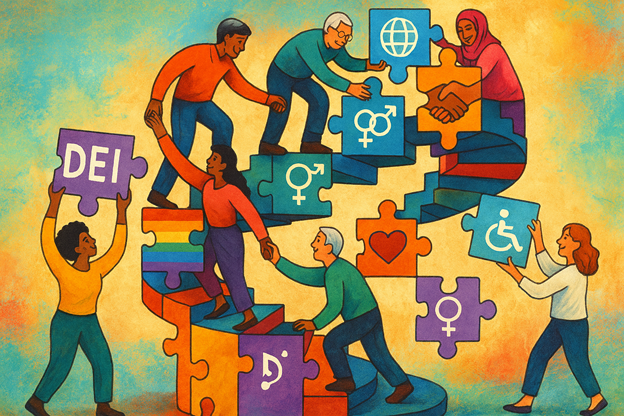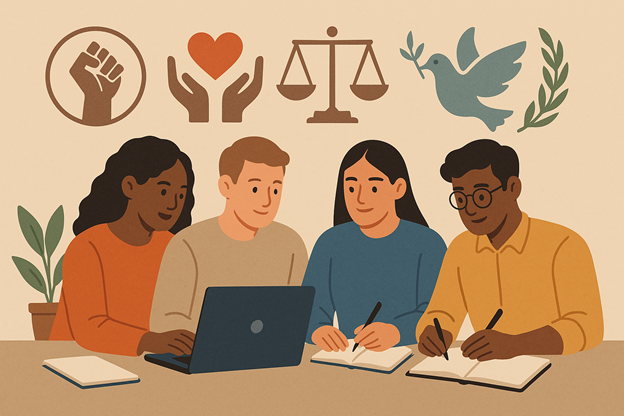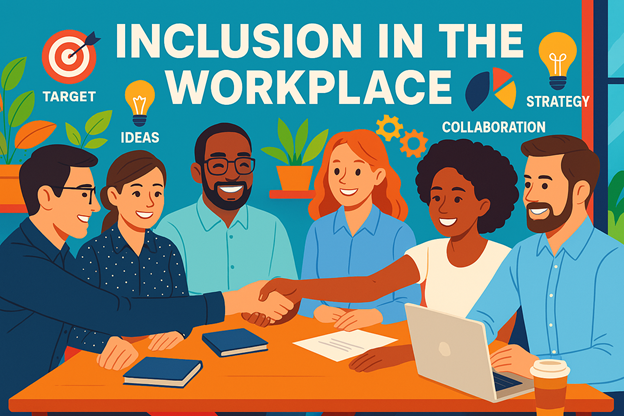From Tolerance to Transformation: Reimagining DEI in Workplaces as a Human Rights Strategy

Table of Contents
- Introduction
- The Limitations of Performative DEI Initiatives
- Human Rights as the Foundation for DEI
- Case Studies: Organisations Leading with DEI as a Core Strategy
- Strategies for Embedding DEI into Organisational Culture
- Measuring the Impact of DEI through a Human Rights Lens
- Conclusion
Introduction
The literature surrounding diversity, equity, and inclusion (DEI) in organisational contexts has evolved significantly over recent years, reflecting a growing recognition of the complexities and challenges inherent in implementing effective DEI strategies. Manalo (2018) highlights the critical disconnect between academic theory and organisational practice, calling for a deeper understanding of how diversity and inclusion efforts can genuinely reduce conflict across various identity lines. This foundational insight sets the stage for understanding the nuances of DEI initiatives, particularly the need to critically assess their effectiveness in fostering genuine inclusivity rather than merely promoting tolerance.
Croy (2018) adds to this discussion by emphasising the role of diversity education as essential in both educational institutions and workplaces. Croy uses social constructivism and critical race theory to highlight the importance of collaborative learning spaces for meaningful diversity engagement. The educational perspective plays a vital role in developing the necessary attitudes and skills for successful DEI practices. M. Thomas (JT) (2018) examines how higher education institutions commodify diversity and claims that their reliance on diversity statistics hides deeper problems of power dynamics and inequality. Institutions that treat diversity initiatives as financial strategies rather than ethical obligations may exploit minority groups without resolving fundamental systemic inequalities. This assessment of diversity's influence on institutional identity highlights the need for deeper commitments to equity within DEI frameworks.
Clohesy and colleagues (2019) offer practical guidance to advance DEI in the field of philanthropy with actionable steps for organisations that aim to integrate DEI principles into their operational frameworks. The authors stress that establishing clear definitions and fostering trusting partnerships is crucial to guarantee successful DEI implementation and widespread acceptance among all stakeholders.
Enders et al. (2021) introduce behavioural nudges as a method for addressing implicit biases in organisational frameworks. Their research demonstrates that concrete strategies can catalyse meaningful organisational change by validating the requirement for intentional and actionable DEI initiatives. Chi et al. (2021) investigate diversity and inclusion in artificial intelligence and question the connection between ethical standards and business accountability. Their research reveals that successful navigation of DEI in AI development depends upon incorporating diverse viewpoints to achieve balanced technological results. The 2022 study by Esparza et al. investigates how medical schools implement DEI initiatives by examining the different definitions and practices across various institutions. The study of DEI leaders' experiences uncovers substantial deficiencies in resources and support, which reaffirms previous criticisms about the lack of depth in many DEI programs. Østergaard & Timmermans' 2023 study contributes to academic discourse by exploring how workplace diversity affects innovation performance. Research findings show that diversity is frequently praised as an innovation catalyst, but empirical support is sparse, which requires additional investigation to determine how diversity can truly benefit organisational performance.
Bosch (2024) concludes this literature review by addressing the paradoxes inherent in organisational justice as it relates to DEI. She argues that achieving true justice in workplace decision-making requires a nuanced understanding of both organisational and social justice, highlighting the need for leaders to navigate the complexities of DEI beyond mere rhetoric.
This body of literature collectively underscores the necessity of moving beyond performative measures in DEI initiatives, advocating for a more profound integration of these principles into the organisational DNA as a means of fostering genuine equity and inclusion in the workplace.
The Limitations of Performative DEI Initiatives
Many organisations adopt DEI programs to project a socially responsible image. However, when these initiatives are not deeply integrated into the organisational culture, they risk being perceived as performative. This section examines the pitfalls of superficial DEI efforts and the potential backlash from both employees and the public.
Performative DEI tends to focus on representation without accountability, inviting diverse employees in, but failing to examine whether they can thrive. Hiring practices may shift, but without an inclusive culture and psychological safety, high turnover and disengagement follow. This shallow approach, sometimes termed "diversity-washing," undermines trust and progress.
Human Rights as the Foundation for DEI
Human rights frameworks, especially post-1948’s Universal Declaration of Human Rights, emphasise dignity, equality, and non-discrimination. These principles are not separate from workplace dynamics—they should be foundational. Embedding DEI into the human rights framework means treating access to fair employment, safe work environments, and equitable advancement as rights, not perks.
The UN Guiding Principles on Business and Human Rights establish that companies have a responsibility to respect human rights across their operations. In 2023, the UN High Commissioner for Human Rights issued a statement urging businesses to uphold DEI as part of their human rights obligations.
When DEI is seen through a rights-based lens, it transforms from a moral preference to a non-negotiable responsibility. This includes combating indirect discrimination, ensuring accessibility, and actively working against systemic bias.

photo created by SoraAI
Case Studies: Organisations Leading with DEI as a Core Strategy
Certain organisations have gone beyond surface-level DEI efforts to embed it deeply in their governance and operations.
Salesforce, for example, publishes annual equality reports, tracks pay equity globally, and links executive bonuses to diversity goals. Their transparent approach to DEI metrics has set an industry standard (Salesforce Equality).
Unilever has tied its sustainable business strategy directly to human rights, including commitments to gender equality, LGBTQIA+ rights, and disability inclusion. In 2021, they committed to ensuring that everyone who directly provides them with goods and services earns at least a living wage by 2030.
These examples show that measurable, transparent, and accountable strategies can align business success with social justice.
Strategies for Embedding DEI into Organisational Culture

photo created by SoraAI
Successful forward-thinking organisations now recognise Diversity, Equity, and Inclusion (DEI) as critical elements for their success. When organisations integrate DEI into their culture and policies, they create inclusive workplaces that satisfy employees and boost performance.
How can organisations shift from tolerance to transformation? Below are practical, evidence-based strategies:
a. Anchor DEI in Leadership Accountability
Make DEI outcomes part of executive performance reviews. Without accountability, initiatives stall. Leaders should receive regular training on unconscious bias and inclusive leadership.
b. Co-Design Policies with Marginalised Employees
Engaging marginalised voices in policy design ensures relevance. This participatory approach echoes the principles of the Capability Approach (Sen, Nussbaum, 2011), which centres lived experience in justice work.
c. Use Data and Equity Audits
Regular DEI audits can reveal hidden patterns of exclusion in hiring, promotion, and retention. Using intersectional data helps avoid one-size-fits-all solutions.
d. Normalise DEI Education Across All Levels
Instead of one-off workshops, organisations should embed DEI in onboarding, team-building, and leadership programs. Experiential learning—role-playing, simulations, storytelling—enhances retention and empathy. (Kolb, 1984)
e. Cultivate Psychological Safety
According to Edmondson (1999), psychological safety, where team members feel safe to take risks, is foundational to inclusive innovation. This principle gained widespread recognition through Google’s Project Aristotle, which found psychological safety to be the most critical factor in high-performing teams. The study concluded that teams where members felt safe to take interpersonal risks without fear of humiliation were significantly more innovative and effective. This requires leaders to model vulnerability, cultivate a feedback-rich environment, and embed inclusive practices into team dynamics.
Measuring the Impact of DEI through a Human Rights Lens
Evaluation is not only about numbers, it’s about justice. A rights-based DEI evaluation approach includes:
- Representation + Experience: Are people from marginalised groups not only present but thriving?
- Process Transparency: Are promotion, pay, and conflict resolution processes fair and visible?
- Belonging Index: Does the organisation track whether employees feel safe, respected, and included?
- Longitudinal Impact: Are DEI investments improving retention, innovation, and well-being over time?

photo created by SoraAI
In 2023, a Harvard Business Review study emphasised that inclusive leaders see a 17% increase in team performance, a 20% increase in decision-making quality, and a 29% increase in team collaboration. (HBR, 2023). This shows us that implementing DEI into a healthy and wealthy organisational culture will accrue in the right way.
Conclusion
In the journey from tolerance to transformation, it becomes increasingly clear that diversity, equity, and inclusion (DEI) must evolve beyond surface-level initiatives into a fundamental human rights strategy that reshapes organisational culture. This shift necessitates a rethinking of traditional DEI frameworks, where merely checking boxes or implementing performative measures falls short of producing genuine change. Organisations must recognise that embedding DEI within their DNA involves not only an acknowledgement of the diverse fabric of their workforce but also a commitment to equitable practices that empower individuals and foster an inclusive environment.
Only by grounding DEI efforts in human rights principles can organisations create authentic pathways for transformation that drive not only social justice but also business resilience and innovation. As highlighted throughout this exploration, leading organisations serve as compelling examples of how DEI can manifest as a core strategic priority, firmly rooted in respect for human rights.
Ultimately, the path forward for sustainable DEI integration hinges on sustained commitment and authentic engagement across all levels. It requires a paradigm shift where leaders become champions of DEI, prioritising systemic change over complacency. By adopting this holistic approach, organisations reaffirm their social responsibility and build resilient, equitable workplaces where transformation is not a distant goal, but a realised practice.

